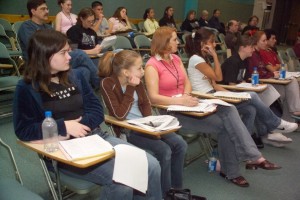 As we trend toward the end of January, Most dioceses sponsor some sort of “Catholic Schools Week” activities. With that in mind a few thoughts occur to me with regard to both the need for alternatives to public school, and the increasing difficulties related to Catholic schools.
As we trend toward the end of January, Most dioceses sponsor some sort of “Catholic Schools Week” activities. With that in mind a few thoughts occur to me with regard to both the need for alternatives to public school, and the increasing difficulties related to Catholic schools.
Indeed, one of the great tragedies of modern Church life is the demise of Catholic Schools. They were founded at a time when Catholics did not want their children indoctrinated in Protestant and secular settings, largely inimical to the Catholic faith. Since faith and the salvation resulting from it was most precious gift of all, the thought of exposing their children to these dangers was of such a concern that parents, along with priests and religious made tremendous sacrifices to built, maintain and support Catholic Schools for their children.
The government, then as now, saw this as a threat, realizing that it could not easily influence Catholic children with modern sectarian notions and thereby build “good citizens” (read: loyal party members).
There were many showdowns where government officials spoke menacingly of Catholic Schools and sought to compel either public education, or to severely marginalize Catholic and other sectarian schools.
Most notably, President Ulysses Grant in 1875 indicated in a presidential address to Civil War veterans that, now that the Civil war was won, “The dividing line will not be Mason and Dixon’s but between patriotism and intelligence on one side, and superstition, ambition and ignorance on the other.” He was referring to the Catholic Church when he said ‘superstition’ and went on to insist that there be no funding for Catholic schools and that Church property be taxed. (quoted in McGreevy, Catholicism and American Freedom pp. 91-93).
Hence public schools, (read: government schools) have long been seen as a necessary vehicle of the secular State, and others with secular agendas, to lay hold of the minds of young people. Catholics understood this and resisted it in an era when our faith was more important to us that it collectively is today.
The demise of Catholic Schools is complex. It is not merely that Catholic parents no longer rate the handing on of the faith as important as in the past, but also that many, parents and priests alike, had come to doubt that Catholic schools were any longer doing that effectively. The handing on of the Catholic faith to the young has become difficult in a broken culture of broken families. Further, some argue that Catholic Educational leaders became too enamored of public school ideologies and techniques.
Nevertheless we need Catholic schools more than ever before, and yet, just when we need them most they are going away, closing by the hundreds every year. Some say home schooling is filling the gap. For a few, yes, but the vast majority of Catholic children now go to government run secular schools where they are daily indoctrinated with trendy and often sinful teachings to include the immoral agenda of the homosexual lobby, condom obsessed sexual “teachings” and all sorts of deconstructionist and syncretistic notions that discredit faith, the Scriptures, and the meaning of the human person, and the existence of God. There is also the exaltation of science in a way inimical to faith, bogus notions of tolerance, agenda laden curricula etc.
I was recently made aware of an article in the Reader’s Digest. And while the article has several purposes beyond the scope of this article I write, I would like to excerpt aspects of the Reader’s Digest article that pertain here and encourage you to read the rest here: American Schools Damaging Kids?. As usual, the original text of the article is in bold, black italics. My comments are in plain red text.
Parents send their children to school with the best of intentions, believing that formal education is what kids need to become productive, happy adults. Many parents do have qualms about how well schools are performing, but the conventional wisdom is that these issues can be resolved with more money, better teachers, more challenging curricula, or more rigorous tests. But what if the real problem is school itself? –
Yes our public schools are failing at almost every level. But the fact is they have become a closed system wherein the goal is really not that your kid knows anything at the end of the day, but that his “ticket gets punched” and he can go to the next level of the failing school system, and then to a “noteworthy” college, and get something called a diploma that supposedly opens doors to him after getting even more pieces of paper called a Masters Degree etc.
So the point isn’t really that your kid knows anything at the end of the day, but that they get their ticket punched for access to the American scene. Obviously the less tedious the process the better, so why care about higher standards? Why care if the kid has ever read the classics, knows their times tables, or can read or write above a 5th grade level? The point isn’t skill, its the punched ticket. Its an unhealthy symbiotic agreement.
The unfortunate fact is that one of our most cherished institutions is, by its very nature, failing our children and our society.
Yes, frankly most come out our schools performing very poorly in terms of basic skills such as reading, writing, grammar, basic mathematics, and the ability to think and communicate well.
Compulsory education has been a fixture of our culture now for several generations. President Obama and Secretary of Education Arne Duncan are so enamored of it that they want even longer school days and years. –
And this is an old government technique, not unique to America, wherein the government wants more time with your kids than you. They want to be the main source of information, values and influence. Why? Power, party loyalty, an ability to craft the future and and bring the citizenry in line.
…Schools as we know them today are a product of history, not of research. The blueprint for them was developed during the Protestant Reformation, when schools were created to teach children to read the Bible, to believe Scripture without questioning it, and to obey authority figures without questioning them. –
Fair enough, the earliest schools in this country were founded with this religious purpose, prior to the American Revolution when most of the colonies had an official religious loyalty. But after the Revolution and the Constitution, things went more secular:
When schools were taken over by the state, made compulsory, and directed toward secular ends, the basic structure and methods of teaching remained unchanged. Subsequent attempts at reform have failed because they haven’t altered the basic blueprint…. The top-down, teach-and-test method, in which learning is motivated by a system of rewards and punishments rather than by curiosity or by any real desire to know, is well designed for indoctrination and obedience training but not much else. …
As a society, we tend to shrug off such findings. We’re not surprised that kids are unhappy in school. Some people even believe that the very unpleasantness of school is good for children, so they will learn to tolerate unpleasantness as preparation for real life. But there are plenty of opportunities to learn to tolerate unpleasantness without adding unpleasant schooling to the mix. Research has shown that people of all ages learn best when they are self-motivated, pursuing answers to questions that reflect their personal interests and achieving goals that they’ve set for themselves.
The article goes on to encourage other methods separate from government schools. To which I utter a hearty Amen.
My “Amen” is not regarding methodologies of education, (I am NOT a pedagogical expert); but anything we can do to dismantle the secular and/or government stranglehold over modern education which has become little less than indoctrination and a big money grab is to be encouraged.
Am I too cynical? You decide. Comments are open both for rebuttals and different options.
Yes, I deeply regret the loss of Catholic schools but admit that too many of them had become weak on faith and were mere clones of the government schools. This is not true everywhere, but sadly it was too often the case. We can only pray that the ones that do remain open will focus on being true alternatives to government schools where the Catholic Faith is effectively handed on. In the mean time it can only be hoped that Americans in general and Catholics in particular become more sober about the increasingly negative trends in public (government) education. Higher priority needs to be given to Catholic alternatives.


